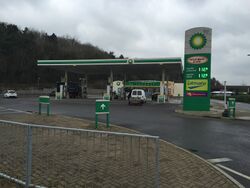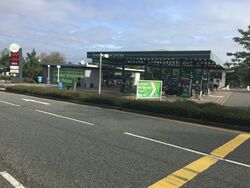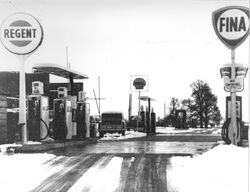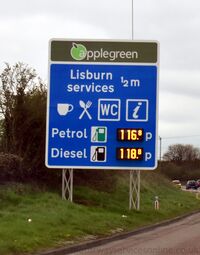Petrol Stations

For the current price of fuel, you need to consult the fuel brand in question.
A petrol station, filling station, forecourt, PFS (petrol filling station), FFS (fuel filling station) are all phrases which effectively describe the same thing. It's also colloquially known as a 'garage' or 'service station', though those phrases are also used to describe mechanics and service areas.
While petrol stations can be found all over the world, this page looks at their contribution to service areas. All signposted services (on motorways and on A-roads) are required to sell fuel, but rest areas are not. The petrol station is the only service area facility which you can be sure will be open at night.
Although most petrol stations are supplied by one of the major oil companies, and covered in their branding, sometimes they are ran by somebody else. At motorway services, it always used to be the operator. As Moto and Roadchef wanted to focus on catering, they have since sold most of their forecourts to the likes of Euro Garages. This has created the unusual situation where the two neighbouring facilities are effectively competing with each other to sell food.
Fuel Pricing
Petrol stations on motorways and major roads frequently receive complaints that they charge prices well above the prices charged locally, especially when compared with supermarkets. Newspaper articles frequently point out that as much as 20p per litre can be saved by driving a few miles. Operators have been reluctant to comment on why their prices are so high, occasionally muttering about high operation costs or pressure from the forecourt brand.
There is a little bit of truth in this. The cheap fuel that is sold in supermarkets makes very little profit, if any. This is fine for a business which is able to subsidise it, but traditionally motorway services were run on tight profit margins with high running costs. Regulations also made it difficult for them to cross-subsidise because motorway service areas are supposed to be competing with each other and not with neighbouring towns.
In practice, a lot of customers of motorway petrol stations are charging the price to their employer, so they are not worried about the bill. This leads to motorists accusing the forecourt of taking advantage of a captive market. Some business fuel cards even charge a flat rate across the country, irrespective of the advertised price.
Complaints about motorway fuel prices were common as early as the 1970s, but a government study found that the prices were not unduly high and that some of the associated offers made for good value.
Petrol stations are not required to advertise their fuel price, but it is common practice that they do, if only to avoid disappointment at the pumps. Highway authorities have explicitly ruled out taking action against service areas with seemingly excessive fuel prices.
Motorway Price Crash

Over the years, several individual service areas have trialled selling fuel at a cheaper price, but they have quickly reverted to their standard pricing structure. Two high profile examples were Washington and Southwaite.
One name may be able to shake things up completely: Applegreen. Their entire business model assumes people will drive a long way to find cheap petrol, so when they founded their business in Ireland they heavily promoted their low fuel prices, hoping that customers would stop to buy more food from them in return. In fact on one occasion Applegreen were told to raise their prices because the queue was disrupting the motorway. In July 2020, Applegreen sold fuel for 24.7 cent per litre in a promotion at some of their Irish motorway service areas.
Having run several Irish motorway service areas like this, and many petrol stations in the UK, Applegreen took over Welcome Break in 2018 and prepared to introduce the same prophecy with them. Starting with a trial site at Hopwood Park, Welcome Break now commit to "lowering fuel prices" and the "lowest motorway fuel prices" - not a bargain but better value than had been offered before. This involved moving Welcome Break's branding to closely resemble Applegreen's.
In the summer of 2020, Moto responded to say they were trialling cheaper fuel prices. Moto's commitment was to compete with local petrol stations (though specifically not local supermarkets) at selected sites, to see whether lower prices would sell in higher volumes. Moto have commissioned a specially-created road sign to promote their cheaper fuel prices.
If they were to roll this out nationwide, it could be the motorway network's first ever fuel price war. Currently their promotion is available at Donington, Frankley and Lancaster.
History

When the first motorway services were being designed, the emphasis was on the motoring side of things. Operators were expected to sell fuel, repair broken vehicles and operate a recovery service - the food and toilets were almost a mere a bit on the side. As a result, it was hard to find a developer who was excited by both selling fuel and serving food.
In addition, the government were very concerned about a fuel monopoly, so they required at least four brands of fuel to be made available - and those brands had to be agreed in writing. That suggestion dated back to an investigation by the Monopolies and Restrictive Practices Commission into so-called 'solus' petrol stations which took place shortly before the first motorways opened. They published a report in 1965, when there were a handful of motorway services open, which remarked that the Ministry of Transport needed to ensure that budget fuel brands aren't pushed out of motorway sites.
The motoring industry changed fast at this time, and the Ministry were more concerned that the requirement to sell four brands of fuel was putting off potential operators. The requirement was informally reduced to two brands in 1973, and then this and other regulations were removed all together in 1979. What followed was a long period where the petrol station appeared to be completely detached from the rest of the service area, while the operators invested mostly in food/retail.
In the late 1980s, as service areas were starting to break free from government planning, oil companies like Esso started taking a key role in designing new service areas. The main operators would then only be involved in the main building. The sales shops also started to become larger, to the point where it is now often a mini-service area in itself, filled with items for sale. By selling food, hot drinks, fuel and having toilets, these petrol station sales shops are now ticking all the boxes expected of a service area, leaving any other facilities (including the main building) free to open and close as they wish.
At smaller service areas, the forecourt shop and main amenity building tend to be combined into one.
The Applegreen/Welcome Break business model of being a fuel brand as well as a food one is like a return to old times, where the whole service area is run under one brand name.
Away from motorways there is no formal planning process, and both oil brands and service area operators can buy land where they think it would be profitable. The two fastest-growing major operators appear to be Euro Garages and Applegreen, both pursuing a policy of building a forecourt and surrounding it with food names.
There are no specific regulations attached to petrol stations at service areas. Operators are "encouraged" to provide free air and water, and to cater for a variety of fuels and vehicle types, but no more detail is provided.
Road Signs

See also: Motorway Signs
Since 1982, motorway signs have been expected to specify the price of fuel. This fell out of favour because it was too difficult to keep up to date.
Since 2012, the forecourt brand logo is expected to be shown on signs, and a fuel price comparison sign has been experimented with on the M5. The sign, initially popular with motorists, didn't appear to increase competition.
The symbols work as follows. While they are supposed to be informative, historically the signs they are attached to haven't been kept up-to-date, and nowadays they tend not to be used.
- white pump symbol on a blue or green sign: generic forecourt sign (added 2002)
- black pump symbol on a white sign: generic forecourt sign (added 2002)
- black pump symbol on a blue or green sign: diesel fuel
- green pump symbol on a blue or white sign: unleaded fuel
- four circles: Four Star fuel
- pump symbol with a round head: old-style generic symbol (removed 1994)
- separate 'LPG' symbol: LPG is available (added 2002)
- separate electric car symbol: a charging point is available